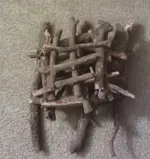Southernhunter
Jr. Member
- #1
Thread Owner
Good day,
I have a short tale ending with a query:
Through research into a mining district beginning around 1850+ and certain events, I narrowed a cache search down to a specific geographic location where I came upon what I call a Jesuit tree, in that it was split in the center and trained to form a neat "U" shape probably around 75 to 150 years old at most.
After digging approximately 5.5 ft down in very compacted soil I came across four layers of limbs laid 4 across and layered 4 deep. The limbs are about the thickness of a silver dollar and show tool marks on the end.
The Spanish miners are renown for their trap trickery and on the concern that that may have carried over, or that they may have a meaning I'm unaware of, my question is; does this have a particular significance?
Thanks for any assistance.
I have a short tale ending with a query:
Through research into a mining district beginning around 1850+ and certain events, I narrowed a cache search down to a specific geographic location where I came upon what I call a Jesuit tree, in that it was split in the center and trained to form a neat "U" shape probably around 75 to 150 years old at most.
After digging approximately 5.5 ft down in very compacted soil I came across four layers of limbs laid 4 across and layered 4 deep. The limbs are about the thickness of a silver dollar and show tool marks on the end.
The Spanish miners are renown for their trap trickery and on the concern that that may have carried over, or that they may have a meaning I'm unaware of, my question is; does this have a particular significance?
Thanks for any assistance.







 maybe a sign that the cache was melted into a bullion?
maybe a sign that the cache was melted into a bullion?

